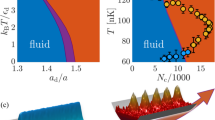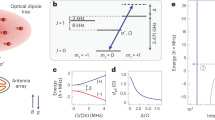Abstract
Adiabatic demagnetization is an efficient technique for cooling solid samples by several orders of magnitude in a single cooling step. In gases, the required coupling between dipolar moments and motion is typically too weak, but in dipolar gases—of high-spin atoms or heteronuclear molecules with strong electric dipole moments, for example—the method should be applicable. Here, we demonstrate demagnetization cooling of a gas of ultracold 52Cr atoms. Demagnetization is driven by inelastic dipolar collisions, which couple the motional degrees of freedom to the spin degree. In this way, kinetic energy is converted into magnetic work, with a consequent temperature reduction of the gas. Optical pumping is used to magnetize the system and drive continuous demagnetization cooling. We can increase the phase-space density of our sample by up to one order of magnitude, with almost no atom loss, suggesting that the method could be used to achieve quantum degeneracy via optical means.
This is a preview of subscription content, access via your institution
Access options
Subscribe to this journal
Receive 12 print issues and online access
$209.00 per year
only $17.42 per issue
Buy this article
- Purchase on Springer Link
- Instant access to full article PDF
Prices may be subject to local taxes which are calculated during checkout



Similar content being viewed by others
References
Lounasmaa, O. V. Experimental Principles and Methods Below 1 K (Academic, New York, 1974).
De Haas, W. J., Wiersma, E. C. & Kramers, H. A. Experiments on adiabatic cooling in paramagnetic salts in magnetic fields. Physica 1, 1–13 (1934).
Kurti, N., Robinson, F. N. H., Simon, F. & Spohr, D. A. Nuclear cooling. Nature 178, 450–453 (1956).
Oja, A. S. & Lounasmaa, O. V. Nuclear magnetic ordering in simple metals at positive and negative nanokelvin temperatures. Rev. Mod. Phys. 69, 1–136 (1997).
Touriniemi, J. T. & Knuuttila, T. A. Nuclear cooling and spin properties of rhodium down to picokelvin temperatures. Physica B 280, 474–478 (2000).
Pecharsky, V. K. & Gschneidner, K. A. Giant magnetocaloric effect in Gd5(Si2Ge2). Phys. Rev. Lett. 78, 4494–4497 (1997).
Morrish, A. H. The Physical Principles of Magnetism (Wiley, New York, 1983).
Kastler, A. Quelques suggestions concernant la production optique et la détection optique d’une inégalité de population des niveaux de quantification spatiale des atomes. Application à l’expérience de Stern et Gerlach et à la résonance magnétique. J. Phys. Radium 11, 255–265 (1950).
Hänsch, T. W. & Schawlow, A. Cooling of gases by laser radiation. Opt. Commun. 13, 68–69 (1975).
Hensler, S., Greiner, A., Stuhler, J. & Pfau, T. Depolarisation cooling of an atomic cloud. Europhys. Lett. 71, 918924 (2005).
Hensler, S. et al. Dipolar relaxation in an ultra-cold gas of magnetically trapped chromium atoms. Appl. Phys. B 77, 765–772 (2003).
Griesmaier, A., Werner, J., Hensler, S., Stuhler, J. & Pfau, T. Bose–Einstein condensation of chromium. Phys. Rev. Lett. 94, 160401 (2005).
Cohen-Tannoudji, C., Dupont-Roc, J. & Grynberg, G. Atom-Photon Interactions: Basic Processes and Applications 382–383 (Wiley, New York, 1992).
Olshanii, M., Castin, Y. & Dalibard, J. in Proc. 12th Int. Conf. Laser Spectroscopy (eds Inguscio, M., Allegrini, M. & Sasso, A.) 7 (World Scientific, Singapore, 1996).
Castin, Y. & Lewenstein, M. Reabsorption of light by trapped atoms. Phys. Rev. Lett. 80, 5305–5308 (1998).
Cirac, J. I. & Lewenstein, M. Cooling of atoms in external fields. Phys. Rev. A 52, 4737–4740 (1995).
Cirac, J. I., Lewenstein, M. & Zoller, P. Collective laser cooling of trapped atoms. Europhys. Lett. 35, 647–651 (1996).
Lee, H. J., Adams, C. S. & Chu, S. Raman cooling of atoms in an optical dipole trap. Phys. Rev. Lett. 76, 2658–2661 (1996).
Kerman, A. J., Vuletic, V., Chin, C. & Chu, S. Beyond optical molasses: 3D Raman sideband cooling of atomic cesium to high phase-space density. Phys. Rev. Lett. 84, 439–442 (2000).
Han, D. J. et al. 3D Raman sideband cooling of cesium atoms at high density. Phys. Rev. Lett. 85, 724–727 (2000).
Wolf, S., Oliver, S. J. & Weiss, D. S. Suppression of recoil heating by an optical lattice. Phys. Rev. Lett. 85, 4249–4252 (2000).
Hijmans, T. W. & Burin, A. L. Influence of radiative interatomic collisions on dark-state cooling. Phys. Rev. A 54, 4332–4338 (1996).
Hancox, C. I., Doret, S. C., Hummon, M. T., Luo, L. & Doyle, J. M. Magnetic trapping of rare-earth atoms at millikelvin temperatures. Nature 431, 281–284 (2004).
McClelland, J. J. & Hanssen, J. L. Laser cooling without repumping: A magneto-optical trap for erbium atoms. Phys. Rev. Lett. 96, 143005 (2006).
Friedrich, B. & Herschbach, D. Statistical mechanics of pendular molecules. Int. Rev. Phys. Chem. 15, 325–344 (1996).
Acknowledgements
We thank our atom optics group for encouragement and practical help. We thank G. J. Beirne for careful reading of the manuscript. This work was supported by the German Science Foundation (DFG) (SPP1116 and SFB/TR 21).
Author information
Authors and Affiliations
Contributions
M.F., T.K. and S.G. carried out the experimental work and data analysis, A.G. carried out experimental work and S.H., J.S. and T.P. were responsible for project planning.
Corresponding authors
Ethics declarations
Competing interests
The authors declare no competing financial interests.
Rights and permissions
About this article
Cite this article
Fattori, M., Koch, T., Goetz, S. et al. Demagnetization cooling of a gas. Nature Phys 2, 765–768 (2006). https://doi.org/10.1038/nphys443
Received:
Accepted:
Published:
Issue Date:
DOI: https://doi.org/10.1038/nphys443
This article is cited by
-
Magnetic-field-sensitive multi-wave interference
Frontiers of Physics (2023)
-
The variation law of exchange dipolar term Bose gas
Applied Physics A (2022)
-
Laser cooling for quantum gases
Nature Physics (2021)
-
Thermometry and cooling of a Bose gas to 0.02 times the condensation temperature
Nature Physics (2015)
-
Spin–orbital dynamics in a system of polar molecules
Nature Communications (2014)



